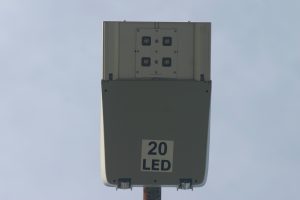After conducting a study, the Department of Public Works has listed a streetlight conversion project as part of its capital plan for FY19. A new project, the conversion has been listed as Tier 2 – to be funded if additional capital becomes available. Significant annual savings – $94,578 – work in its favor, and a funding request for the project may go before Town Meeting in the spring, according to Carys Lustig, Supervisor of Administration for the DPW.
Lustig recently updated Green Needham on the details of the project and the feedback the town received from residents.
The hope is to get approval to fund the project before the end of 2018 because the state’s Metropolitan Area Planning Council (MAPC) will contribute funds to the project, further reducing cost.
According to the Capital Plan, the MAPC will contribute $163,000 of the $658,000 total project cost, if the installation is completed by the end of 2018.
“That’s one of the reasons we put it in the capital process this year,” Lustig said.
By installing the lights, Needham will also enjoy a utilities incentive, as the lights will reduce energy use. “Not only will there be energy savings, there will be decreased energy costs,” Lustig said.
Those financial incentives, along with environmental benefits and the need to replace the existing lights, prompted the project. LED lights are more energy efficient and have a longer life cycle than non-LED lights like the ones currently in use.
The longer life cycle also means less maintenance cost. According to the MAPC, comparable communities that have replaced streetlights have also secured maintenance contracts at significantly reduced rates because of the longer life and higher reliability of LED lighting. At those levels, Needham could save up to an additional $30,000 per year.
Needham currently uses high pressure sodium street lights. The lights, which have a life cycle of about 10 years, need replacing, making it the opportune moment to look into LED lights.
“It’s a good time to convert our lights as we’re replacing bulbs,” said Lustig.

In order to determine whether to pursue LED lights – and which LED lights to pick – the town conducted a pilot study this spring, and tested three different lights installed on three streets off of Great Plain Avenue. The town then gathered feedback from residents using a public survey.
According to Lustig, the color spectrum and harshness of the light was a common concern in resident feedback. Many preferred the LED light with a warmer glow.
The results of the survey identified LeoTek’s ec1 light, at 3,000 Kelvin as the preferred LED option. This option offered the same energy and cost efficiency as other LED lights but also provided the warmer glow important to residents.
Another benefit of the preferred LED is option is that it is compliant with the Dark Skies Initiative. The initiative aims to help communities reduce light pollution, and some Needham residents have expressed interest in supporting it.
While the selected LED light is compliant with the Dark Skies Initiative, Lustig emphasized that the lights would still provide ample light on the street. The difference is that less light would shine upwards towards the sky.
Though Needham mainly used the survey as its information source, it also worked with nearby communities like Dedham and Natick, which have undertaken similar LED projects.
In fact, it was Dedham that recommended using the pilot program to research options.
Should the project not receive funding this time around, Lustig said, the town would likely take down the LED samples used for the pilot program, and reinstall the high pressure sodium street lights.

